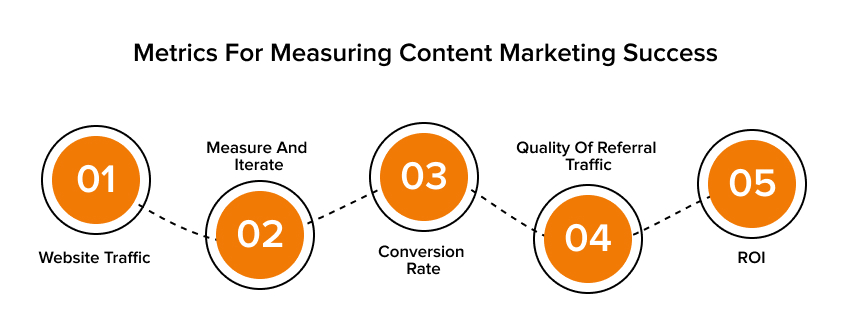We’re constantly consuming content in all forms: images, videos, e-newsletters, pdf, and much more. Using content marketing, companies reach out to their audience with their messaging. The right content makes the brands stand out among its competitors. You could use a short-term strategy with campaigns for time-bound promotions, establish your authority over time, and build a loyal and concentrated following.

Companies take up content marketing with various intentions. As part of your overall digital marketing strategy, content helps achieve your goals partly or wholly. Use content marketing to understand what your audience enjoys, and based on the results, design the rest of your campaign or overall marketing strategy.
Importance of content marketing in the digital age
You may decide against implementing content marketing. But wouldn’t you like to know why more brands continue to increase investment in content marketing? According to CMI, content marketing brings thrice as many leads as traditional outbound marketing. In another survey, about 42% of B2B marketers shared that content marketing content is extremely effective. Some of the benefits of content marketing are:
Win trust: Valuable content relates with your audience well and makes them want to follow your company or brand closely. As a result, they trust your word or services and improve your company’s reputation.
Better leads: You can also generate leads with content marketing. You encourage your audience to try out your product or services by presenting them with relatable content.
Develop industry or niche authority: With quality content, you establish your company’s expertise on a subject or domain. When you share rare, useful, practical, or valuable knowledge, you gain the industry’s trust as a leader.
Importance of Audience Understanding in Content Marketing
We consume what interests us or makes a difference in our lives. Content marketing helps the audience get to the bottom of the funnel with targeted messaging. A proven method of gaining customers’ trust is studying their desires and incorporating value in your content. For example, a restaurant business shares a story about a cuisine’s origin and why a cult loves it. This creates awareness and interests someone to go ahead and try the restaurant’s dish.
It’s also important to understand your audience’s level of understanding before you design content. For example, a seasoned motorcycle owner may look to upgrade their travel gear, while a beginner may need help finding it. So the content must incorporate the target audience’s awareness stage and perspective for the best impact. The importance of content marketing lies in its ability to engage and educate audiences, build brand credibility, and drive meaningful interactions, eventually leading to increased conversions and long-term business growth.
Setting Goals for Content Marketing Success
Businesses searching for ways to create content for the digital age must focus on producing engaging, multimedia-rich content optimized for search engines and mobile devices and tailored to meet the evolving preferences and consumption habits of digital-savvy audiences. Setting measurable goals is crucial to understanding if your efforts take you in the right direction. For example, content marketing could be an experiment when targeting a new audience or demographic. With goals and milestones, you may be able to know if you’ve taken the proper steps.
Make your business known
People can only buy from you if they know your business. Therefore, establishing or increasing the visibility of your business must be a top priority. It is also an ongoing and regular activity. Your goal should be to increase the visibility of your business on the web.
Attract new customers
Just having visibility won’t bring any revenue. That is why it’s said, “Social media likes don’t pay the bills.” You want customers that pay, who come back to you when they need your service or product. Set a goal for conversions to increase month-on-month or year-on-year so you’re not struggling for revenue when the going gets tough.
Align with overall marketing goals
Content marketing must branch out from your company’s marketing strategy. This helps to benefit the larger objective of your business. In addition, aligning overall marketing and content goals brings consistent messaging and a unified brand voice across different marketing channels, enhancing brand perception and customer engagement.
Benefits of a Content Calendar for Content Marketing
Content marketing needs to be planned well in order to yield stupendous results. Creating a content calendar is one of the key ways to deliver quality and impactful content. Completing the content calendar lets your team prioritize tasks and adjust ad hoc tasks. In addition, the calendar gives visibility to the functions and helps shift the task priorities in case of any strategy change. The benefits of content marketing in the digital age include increased brand visibility, enhanced audience engagement, and improved customer trust and loyalty.
Choosing the Right Channels for Content Marketing
If you have competitors (sure, you must), check out how they market their content by signing up for their newsletter, auditing their paid campaigns, and following their social media channels. Analyzing their engagements lets you know what your target audience is receiving. But, of course, these tested channels must have your presence too. Email, website blogs, and social media channels, including Instagram, YouTube, and Facebook, are among the popular channels. But it would help if you also looked at channels like Quora, where your prospects spend a good chunk of time and engage by asking questions or expressing interest.
Tips for Creating High-Quality Content for Content Marketing
Creating high-quality content that resonates with your audience requires careful study of your competitors, industry standards, and innovation. Follow these tips to drive engagement while supporting your content marketing goals.
- Research, research, and research: The more you know about your prospects, the better content you can churn. Know their pain points, their objectives, the solutions they’ve tried, and accordingly incorporate these findings into your messaging.
- Win trust with reliable content: “If people like you, they’ll listen to you, but if they trust you, they’ll do business with you” – Zig Ziglar. You build trust by providing fair value to people.
- Search intent: Does your reader know if they have a problem? Are they ready to buy yet? Knowing what your prospects are looking for should be your starting point, and it increases the likelihood of prospects reading and engaging with your content.
- Unique and presentable content: You must create content that is different from the competition and yet be engaging. Repeated content doesn’t get the audience’s attention and doesn’t favor search engines. Use whitespace, line breaks, bullets, and relevant images for easy reading and comfort for the reader. The better the content relates to the readers, the better it connects.
- SEO optimized: Making your content SEO-friendly helps increase its reach on the web. You can use relevant keywords, meta tags, and descriptive headings.
- Right CTAs: You want your content readers to take action. Place call-to-action links at strategic locations within your well-presented copy so readers take action, like filling out a form or subscribing to the newsletter, or downloading the resource.
Best Practices for Content Distribution and Promotion
Create a detailed plan for distributing your content. Include traditional and non-traditional ways to give your content more ways to reach your target audience. Here are some of the best practices to effectively distribute and promote your content.
Choose your channels well:
Distribute content to media where your audience is active and engaged. For example, you may include industry forums and relevant online communities.
Leverage Social Media:
Distributing your content via social media is a given. Attention-grabbing copies with graphics entice viewers to click and take action. Inspire your audience to like, comment, and share your content to boost its reach.
Influencer Outreach:
You can collaborate with social media influencers who are persons or groups with a large following. Set the targets, agree on the collaboration terms, and evaluate the campaign’s effectiveness. This can immensely increase your content’s visibility and credibility.
Metrics for Measuring Content Marketing Success

Here are some key metrics that can provide valuable insights into your content marketing efforts.
Website traffic:
Monitor the website traffic to understand how your content campaigns affect traffic inflow. Measure the timings of your campaign so you know which campaigns, days, and times bring the most traffic.
Measure and iterate:
Track the performance of your content using various analytics tools. Analyze metrics such as time on page, bounce rate, pages per session, and conversions to identify what works well and make data-driven improvements accordingly. Higher engagement means your content resonates with your audience.
Conversion rate:
Conversions are a step towards your final goal.
Calculate the visitors’ percentage who take a desired action, like downloading a resource, buying a product, filling out a form, or subscribing to a newsletter. This metric shows how effectively your content drives conversions and achieves your goals.
Quality of referral traffic:
Backlinks and referral traffic tell a lot about your credibility and the quality of your content. Monitor the number of quality backlinks your content generates from other websites and the amount of referral traffic it drives.
Search engine rankings:
Check the impact keywords have on search engine result pages. You’re in the right direction if your targeted keywords are increasing the search engine ranking.
ROI:
Measure the content production, promotion, and distribution cost against the number of conversions and determine how your content marketing investment is paying off.
A growing newsletter subscriber base or the number of resources downloaded signifies that your content reaches the right audience.
Mistakes to Avoid in Content Marketing
The role of content marketing in the digital age is to help businesses establish a solid online presence, engage their target audience, and drive profitable actions like subscribing or making purchases.
Here are content marketing follies to be aware of while executing your strategy.
Writing for the incorrect audience:
Generic content pleases nobody. On the flip side, you must know the solution your reader is looking for and add value to your content. Neglecting the awareness stage of your audience will mean your content will not reach the correct audience.
Lack of consistency:
Your content must have a varying focus to make sure the reader understands and you avoid losing their interest in your brand. Keep your messaging consistent. Talk entirely about one subject to keep your prospects interested and engaged. Inconsistent messaging and tone across your content can confuse your audience and weaken your brand’s identity.
More content with lesser quality:
The goal of content is to get personalized and aim to solve the customer’s problem. Pushing generic articles with less focus on the user’s pain points doesn’t connect with the audience, resulting in a dropping number of followers and subscribers.
Lack of distribution and promotion:
Great content promotes itself. But there will be occasions when even good content needs more reach. That’s why it’s vital to have a consistent promotion and distribution approach in place. Use email marketing, social media, influencer outreach, and other channels to increase your content’s reach.
Not adapting based on insights:
You must change your strategy by analyzing the trends with your audience. Do more of what your audience appreciates or engages with and rethink what does not work. Track and analyze relevant metrics regularly to get cues for content performance.
Emerging Trends in Content Marketing

Keeping up with the current trends strikes a chord with your audience. So check out these trends and see if they’re part of your strategy.
Personalized content:
Feels good when someone addresses us by name, right? Content marketing, primarily when distributed on a one-on-one basis, must be personalized. Say you receive two emails. One with a generic subject and the other with your name + action/question. Aren’t you likely to open the one with your name in it?
Right size, the right form of content:
Short video form content is popular today. But there is a large set of audiences who seek longer, in-depth articles about complex subjects over shorter content. With trends, you must analyze the size and form of content that’s popular and preferred by your audience to increase readership or viewership.
Interactive content:
Another popular content trend is interactive content. This content includes quizzes, mini-games, fun tests, calculators, surveys, etc. It allows the audience to participate actively with your content and feel more engaged with your brand or campaign.
Podcasting:
Podcasts continue to become popular as an effective content marketing channel. Audio storytelling and conversational podcasts are popular and less expensive to produce. In addition, podcasts with collaborations make it exciting for prospects to look forward to consuming.
Conclusion
Creating hyper-personalized content gets your audience’s attention, but trends keep changing from time to time. Content marketing is an opportunity to reach, engage and win your prospects. You can showcase your brand as a thought leader or domain expert with our guide.
With well-thought content strategies and high-quality, valuable content, businesses get an edge in attracting customers, building credibility, and driving revenue and conversions. Content marketing helps retain customers while also winning indecisive customers.
Businesses must establish a clear and comprehensive strategy to unlock the maximum benefits of content marketing. This requires conducting in-depth audience research to understand their preferences and needs. It’s equally important to ensure effective distribution and promotion of the content across appropriate channels.
By integrating content marketing into their overall marketing strategy, businesses can gain a competitive advantage, forge deeper connections with their audience, and pave the way for sustained success in the ever-evolving digital landscape.
FAQs
Content marketing is a strategic approach that creates and distributes valuable, relevant, and consistent content to attract and engage a target audience. It is even more important in the digital age because consumers are overloaded with information. As a result, businesses can stand apart in the crowded and generic world by delivering content that addresses customer needs and provides value.
Content marketing, done right, builds a loyal following and helps to convert them to paying customers. As a result, you can drive traffic to your website, gain leads and retain customers.
Your marketing goals, industry trends, and target audience determine the content strategy. Some popular content types include blog posts, short-form videos, interactive content, eBooks, infographics, and podcasts. In addition, you can check what your competitors are doing and continue marketing on the same platforms to keep your presence.
Website traffic and constant engagement on social media are indicators for determining the effectiveness of your content marketing. Other metrics include conversion rates, time spent on the page, email open and click-through rates, and social media reach. In addition, free tools like Google Analytics help you gain valuable insights about your content marketing campaigns.
Monitor the trends, stay updated on your audience’s preferred consumption and behavior, and align your content marketing goals with your overall goals. Review the comments and ask for customer feedback to stay relevant and up-to-date. Finally, implement the latest technologies to save time and stay ahead of competitors.



